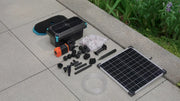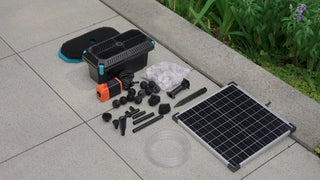
The gentle splash of a fountain is the heartbeat of a pond. When that beat falters—shorter spray, rattling sounds, frequent stalls—you’re left wondering if it’s time to replace your fountain pump or just clean it. Here’s a practical, no-nonsense pump replacement guide you can use today, plus pro tips for stretching fountain pump life expectancy with the right maintenance and Poposoap gear.
Pump Life Judgment Criteria
A well-cared-for submersible pump typically runs several seasons. Longevity depends on water quality, run-time, head height, and how often you clean the intake and prefilter. Use these criteria to judge remaining life:
- Stable flow at normal head: If the pump still reaches its usual height/pattern after a standard clean, it’s likely healthy. Persistent under-performance hints at wear in the impeller or motor.
-
Quiet operation: A smooth hum is normal; grinding, rattling, or intermittent squeals point to shaft or bushing wear.

- Reliable restarts: Healthy pumps restart immediately after brief shutoffs (e.g., cleaning or panel shade). Needing multiple taps or power cycles is a red flag.
- Normal temperature: Submersibles run warm, not hot. Repeated thermal shutoffs or very hot housings suggest internal resistance or blockage.
- Clean electrical behavior: Tripping a GFCI or blowing fuses—even after you’ve ruled out wiring and moisture—usually means the motor is nearing the end.
Replacement Signals and Test Methods
Before you replace a fountain pump, run these quick diagnostics:
- Bucket flow test: Place the pump in a bucket and time how long it takes to fill a measured container. Compare to the model’s approximate flow class (e.g., 80–160–280–580 GPH tiers). A drop of ~30% or more after cleaning often indicates mechanical wear.
- Head height test: With the standard nozzle, note the maximum consistent spray when your panel or power is stable. If head height keeps collapsing despite clear plumbing, the impeller or rotor may be worn.
- Impeller inspection: Disconnect power, open the intake cover, and inspect for chipped vanes, swollen bushings, or magnet scoring. Replace the impeller if available; if not, replace the pump.
- Start-stop reliability: Cycle power 5–10 times. Laggy, hesitant starts are a sign of winding or bearing fatigue.
- Noise/vibration check: Hold the housing while running in water. Harsh vibration that persists after debris removal usually means end-of-life.
Replace the pump if two or more tests fail, or if performance declines again within days of a thorough service.
Purchase Suggestion
When it’s time to upgrade, choose a pump that fits the feature—not just the box rating.
- Match flow to purpose: For birdbaths and patio bowls, choose compact solar fountain pumps that prioritize wide, oxygenating spray over tall jets. For mid-size ponds, step up to a solar fountain pump in the 10–30 W class for dependable circulation and moderate head. Large decorative ponds benefit from higher-throughput solar models or floating fountains that spread aeration efficiently across the surface.
- Right-size head pressure: Every bend and rise steals flow. If your waterfall or spillway is taller than a meter, consider a stronger class pump and keep hose runs short and smooth.
- Filtration first: Pair the pump with a Poposoap Pond Filter Kit or Filter Box with Filter Media so solids don’t enter the impeller. Layered foams + bio-media stabilize clarity and cut maintenance.
- Choose off-grid simplicity: Poposoap’s Solar Fountain Pumps and Floating Pond Fountains include remote panels and long leads, so you can place the panel in sun and the pump where it looks best—no trenching, no cords across the lawn.
Think ecosystem: If you keep fish, consider adding a Poposoap Solar Pond Filter or Waterfall Kit to raise oxygen and keep ammonia in check. A balanced system makes your new pump last longer.
Poposoap Maintenance Measures
Poposoap designs its pond gear for low-hassle care—key to maximizing fountain pump life expectancy.

- Keep the intake clean: Rinse the prefilter sponge or intake foams every 2–4 weeks in pond water (not chlorinated tap). A clean prefilter often restores “like-new” flow.
- Protect against clogging: Run the pump inside a Poposoap filter box or pair it with an all-in-one Pond Filter Kit so leaves and string algae are intercepted before they reach the rotor.
- Lift off the bottom: Raise the pump 5–10 cm above the floor (flat stone or stand) so silt doesn’t get sucked directly into the intake.
- Maintain circulation: A Floating Pond Fountain or Solar Waterfall Kit improves oxygen and reduces protein film, helping bio-filters work efficiently and keeping loads off the pump.
- Seasonal care: In freezing climates, remove and store small submersibles wet (in a bucket of water) or position the intake higher so you don’t disturb the warm bottom layer. In leaf season, check prefilters weekly.
- Panel hygiene (solar): Wipe dust and pollen from panels; aim toward midday sun and reposition seasonally for consistent output.
Installation Guide
A careful install is your best insurance against early replacement—and the heart of any pump replacement guide:
- Plan the hydraulics: Keep hose runs short and uncluttered. Use the largest practical hose to minimize friction.
- Seat the pump correctly: Place it level on a stable pad or inside a Poposoap filter box. Confirm the intake is fully submerged before powering on.
- Connect the return: For fountains, fit the selected nozzle and start low; raise height only if flow remains steady. For waterfalls, test sheet quality and adjust weir level.
- Route power safely: For solar systems, mount the panel where it actually gets sun and create a drip loop at connections. Tidy low-voltage cables beneath edging stones or conduit.
- Prime and test: Fill lines, purge air, and run the system for 10–15 minutes. Check for kinks, micro-leaks, or cavitation sounds.
- Set your maintenance cadence: Add a calendar reminder to rinse prefilters, check panel angle, and swish filter foams in pond water bi-weekly during peak season.
Bottom line: Pumps rarely fail “all at once.” Flow declines, heat rises, restarts get flaky—that’s your cue. Use the tests above to decide when to replace your fountain pump, then choose a right-sized Poposoap solar pump with proper prefiltration. With smart installation and easy, routine care, you’ll extend fountain pump life expectancy, cut costs, and enjoy that steady, calming splash for years.










